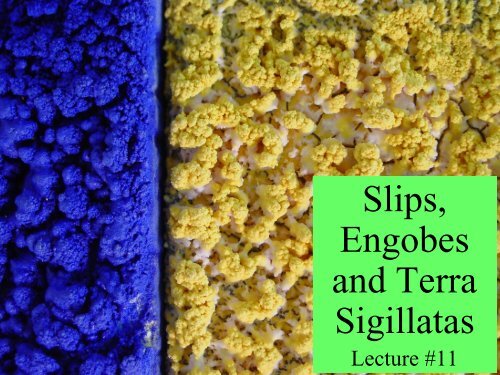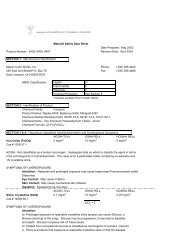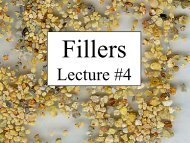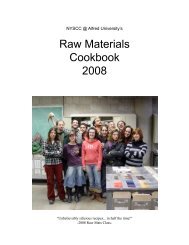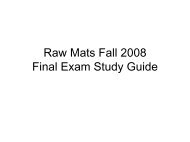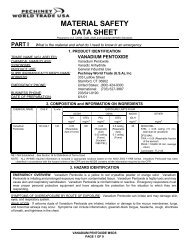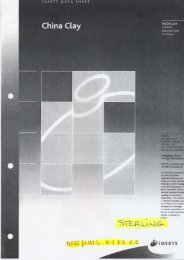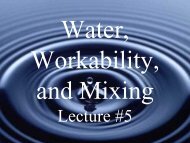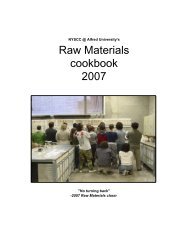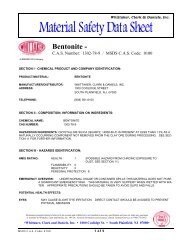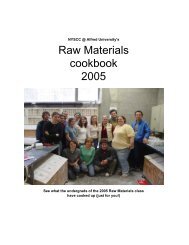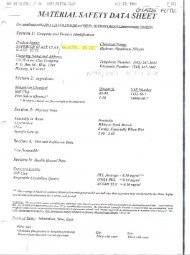Slips, Engobes and Terra Sigillatas - Alfred's Clay Store
Slips, Engobes and Terra Sigillatas - Alfred's Clay Store
Slips, Engobes and Terra Sigillatas - Alfred's Clay Store
- No tags were found...
You also want an ePaper? Increase the reach of your titles
YUMPU automatically turns print PDFs into web optimized ePapers that Google loves.
<strong>Slips</strong>,<strong>Engobes</strong><strong>and</strong> <strong>Terra</strong><strong>Sigillatas</strong>Lecture #11
<strong>Slips</strong> <strong>and</strong> engobes• Historically used in Europe to make red clays look likeimported white porcelain• <strong>Slips</strong> <strong>and</strong> engobes are used for many different reasons– Create a dense surface over an otherwise porous body– Allow for a vast pallet of color <strong>and</strong> texture– Cover up surface imperfections/roughness/even iron spots– Improve glaze fit without adjusting the glaze or the claybody (buffer layer)• WYSIWYG– Don’t run– Don’t pinhole (during firing)
Glazing over slips• Great way to achieve bright, glossy surfaces while notworrying about colors running or bleeding into eachother• Clear glazes applied over slips– Physical depth of clear glass can show off the textural qualitiesof the underlying slip (difficult to achieve with glaze alone)• Glaze composition influences the color of the slip– Lead glazes tend to dissolve slips, blurring edges (Slipware)– Alkaline glazes produce brilliant results• Semi-opaque glazes over slips provide many options forrich, mottled results– Especially when glaze thickness varies– Dark oxides (iron, manganese, cobalt etc.) in the slip bleedthrough glaze
• Traditionally– <strong>Slips</strong> are made exclusively of clay• For wet to leather hard application– <strong>Engobes</strong> always contain fluxes <strong>and</strong> fillers <strong>and</strong>usually contain clay• Often used for bisque-fired ware• Usually, though not exclusively, denser than slips• Today we call both categories “slips”• <strong>Slips</strong> are distinguished by the state of theware to which they are applied <strong>and</strong> by theextent of vitrification– I.e. Vitreous or non-vitreous slip• for wet, leather hard, green, or bisque application
Formulating slips• A slip can be made by using the clay body itself,minus any large fillers (i.e.. No grog)• Advantage– Compositionally very similar to body• CTE is almost identical to body• Drawbacks– Slip must be applied to very wet clay to avoid cracking– Slip can’t be lighter in color than the body withoutradically changing the sources of clay• To improve on these limitations <strong>and</strong> to tailor theslip to our need, we often include other ingredientsin a slip
• Much like a clay body, slip ingredientsusually include:–<strong>Clay</strong>s– Fluxes– Fillers• A slip may also require:– Hardeners– Opacifiers– Colorants• These additions depend on the composition of the slip
<strong>Clay</strong>s• Chosen for their relative color <strong>and</strong> shrinkage• Light colored clays are necessary for a wide pallet ofcolors– Especially true when developing light colors• Combinations of kaolin <strong>and</strong> ball clay are normallyused to adjust shrinkage– More ball clay = more shrinkage– More kaolin = less shrinkage– Total clay is usually between 40-80%• Improve slip’s adherence to the body in dry state• Help keep slip in suspension• Improve the brushing qualities of non-plastics
Fluxes• Help fuse the slip to the body• Selection is temperature dependent <strong>and</strong>reflects what we already know for claybodies– High temp-Feldspars/+auxiliary fluxes– Mid temp-Neph Sy/Talc/Frits– Low temp-Frits/Talc• Color response to oxides or stains will beenhanced or impeded by our choice flux– Similar to a glaze in this respect
Hi Soda3110Hi Calcium/Boron3124Hi Calcium/Boron/Alumina3195Hi MagnesiumTalc
Fillers• Silica is the most commonly used– Promotes hardness (depending on the amount of vitrification)– Reduces drying shrinkage– Promotes whiteness• Pyrax can also be used (though not as white as flint)• Talc (color killer)• Wollastonite• Calcined clay• Filler content usually ranges from 15-30%
Hardeners• Used to improve hardness of slip after drying (antismudging)– <strong>Slips</strong> high in clay usually don’t require additional hardeners– Required in low clay-content slips (esp. when ball clay is absent)• Inorganic– Borax is soluble• Recrystallizes when it dries, forming a tough finish• Can be used up to 5% but other fluxes may need to be decreased (borax isa boron source so it acts like a flux)– Bentonite/Vee Gum• Fine size hardens upon drying (add up to 2%)• Organic– Sugar– Gums (CMC, Gum Arabic)– Spoil with time/can migrate to the top of the container
Opacifiers• Help ensure whiteness <strong>and</strong> allow for thin applicationwithout loss of opacity• <strong>Clay</strong> is opaque; recipes low in clay depend on opacifiers– Not as necessary when dark stains/oxides are used• Tin Oxide– Traditional opacifier (600+ years); gives warm whites– very expensive!• Zircopax (zirconium silicate)– Cooler whites (can be compensated with small rutile additions);more affordable than Tin• Opacifiers tint colors– Don’t use if black/dark colors are what you want– Will impede the development of saturated colors (I.e. yellow, redetc..)
Colorants• Can be added as either oxides/carbonates or stains• Oxides/carbonates– Cheaper than stains– Limited pallet / more variation in color• Developing strong colors in slips requires largeramounts of colorants than for glazes– Glass in glaze provides depth <strong>and</strong> brilliance– The drier the slip, the more difficult strong colorresponse is (i.e. vitreous slips are better c<strong>and</strong>idates forstrong color than dry, non-vitreous slips)• Addition amounts– Vary with stain/oxide used; lighter colors require more• I.e. Yellows require 10-15% stain• Blues require just 3% Cobalt Carb. (even 0.25% is noticeable)
Colorants• Mottled <strong>Slips</strong>– Additions of granulated materials (I.e. rutile, illmenite,manganese, homemade aggregates)– Oxides – More mottled– Carbonates – Less mottled/more homogenous• As in glazes, oxides present in slip will push or pull colors– Some commercial stains will not give the intended color in thepresence of certain oxides, especially zinc• Mason color chart identifies these (Esp. greens, purples <strong>and</strong> pinks)• Cautionary note:– Many metal oxides are not food safe in slips (because slips lackthe glassy structure found in glazes)• If its not safe in the raw state, chances are it won’t be safe in a fired slipeither
Slip compositions• Note changes in flux (for temperatureranges) <strong>and</strong> clay (for application ranges)
Comparing bodies to slipsV.C. HF 4 All purpose white base slipCone 9-12Grolleg30EPK15XX Sagger25• Kaolin• Kaolin• Ball <strong>Clay</strong>Nepheline Syenite 15 • Soda SparFlint 10Wet to leather hard application70% <strong>Clay</strong>V.C. Off White Throwing PorcelainCone 9-10Tile #630• KaolinEPK15• KaolinC&C15• Ball <strong>Clay</strong>Kona F-4 20 • Soda sparFlintPyrax1010Macaloid +160% <strong>Clay</strong>•Moresimilaritiesth<strong>and</strong>ifferencesbetween thetwo• Could we usea slip as aclay?
Wet vs. Bisque• Wet application slips– High clay = creamy quality perfect for painterlyqualities– Wet clay <strong>and</strong> slip can be carved as one (sgraffito)– Ideal for slip trailing/thick, textural layering• Bisque application slips– Timing is irrelevant (ware can be slipped at leisure)– Application can be washed off <strong>and</strong> reapplied– Can be applied over glazed ware– Work undergoes distortion from drying <strong>and</strong> firingbefore slip is applied (great for precise work)
Bisque application slipsV.C. AT 1 White Vitreous SlipCone 6-10VelvacastCalcined KaolinXX SaggerCuster FeldsparNepheline Syenite101052510Flint 30Borax 5Zircopax 5C19-1 Dense Bisque SlipEPKKaopaqueGlowmaxWollastoniteFrit 3124Flint 6Molochite 200 Mesh 20CMC +125% <strong>Clay</strong>Cone 04451594124% <strong>Clay</strong>• Val’s slip uses calcined clay• Not creamy compared towet application slips• For thick applications– Best applied through spraying– Uses very little raw clay– Glowmax is calcined kaolin– Molochite is added as a filler
The shrinkage myth• Many bisque-application slips call for large amounts ofcalcined clay– Myth… During drying, raw clay shrinks / calcined claydoesn’t–Truth… Water separates particles in both cases…even if youuse just calcined clay, you will get shrinkage (not as much aswith raw clay, but still enough to cause problems)• Including plastic clay in the recipe increases the strengthof the slip during drying <strong>and</strong> can help it overcomecracks as the slip is placed in tension during drying(calcined clay has no strength to overcome this tension)– Adding too much plastic clay, however, will ultimatelyincrease shrinkage, tension, <strong>and</strong> cracking…A balance isneeded!
<strong>Terra</strong> sigillata• From Latin – “sealed earth”–1 st century B.C. (spread by the Roman empire)• Historically used to seal a porous clay– Also used in drain tiles to make them waterproof• Usually applied to leatherhard-dry clay• A true slip – Contain just clay• Made of extremely fine particles (approaching colloidalsizes)– Much finer than regular slips• Much more opaque than regular slips– Consequently requires a much thinner coating than regular slips
<strong>Terra</strong> Sigillata• Dense, silky-smooth, sometimes glossy– Gloss is temperature dependent based on the clay used• Generally retained up to C. 04; some can go to C. 2• Gloss is enhanced by burnishing (re-orients clay particlesparallel to the surface)– Burnishing tools are typically smooth (spoon, river-bed stones);cloth also works well (t-shirts, cheesecloth, dry-cleaning plastic)• Historically red clays were used, but any plastic (fine)clay can be used– White sig. can be prepared from ball clays or kaolins
Basic FormulaWater 70%Dry <strong>Clay</strong> 30Darvan #7 0.1-0.3%• Can be made from a body, though most nonplasticswill settle• The type of clay used will determine how muchwater, dispersant <strong>and</strong> settling time is required• Finer clays (i.e. plastic vs. non-plastic kaolins)<strong>and</strong> longer settling times tend to produce moresheen at the expense of opacity
• Ball mill ingredients<strong>and</strong> place in jar,undisturbed for threedays• After three days, layersshould be well defined• Top layer is siphonedoff• Sig. is then carefullysiphoned off (carefulnot to include bottomlayer)• Will have consistencyof milk (not cream)Procedure formaking terrasigillata(from Val’s Book)
• Anton suggests that ball milling is notnecessary• Suggests only leaving the mix to settle for afew hours (not a few days)• Also, suggests that if stains are to be added(up to 30%), this should be done after theSig. is prepared, as they will settle veryquickly– Always stir the Sig. well right before using• If you plan on working with <strong>Terra</strong> Sigillata,read his book!
Like GeologyMaking a <strong>Terra</strong> Sigillata takesadvantage of settling, allowing us toisolate specific materials
Almost like a Casting Slip• Uses a dispersant to lower viscosity, like acasting slip• But, whereas in slip casting we are trying tokeep everything suspended, in a <strong>Terra</strong> Sig.we are trying to keep only the finestmaterials in suspension• How? By adding lots of waterCasting Slip40% water<strong>Terra</strong> Sigillata70% water
Drawbacks to <strong>Terra</strong> Sigillata• Glazes cannot be layered overtop of <strong>Terra</strong> Sigillata– Glaze tends to dissolve terra sig. layer• <strong>Terra</strong> sig. is too thin to withst<strong>and</strong> glaze fusion• A lot of clay is wasted in preparing terra sig.– 50 lbs. of ball clay yields roughly 2 gallons of sig.• This can be somewhat improved by ball milling• Preparation can be somewhat tedious• Limited firing range
Spackle• For very thick applications on bisque ware• Meant to be applied thick, then s<strong>and</strong>ed when drybefore firing• Very low shrinkage due to ideal particle sizedistribution– Screened material• Lots of calcined materials– Esp. clays• Raw clay is used sparingly (10-15%) to suspendmixture• Empirical testing (trial <strong>and</strong> error) is necessary
• Extreme thickness change from top (thick)surface to the sides (thin) caused separationin earlier tests
Adding salt to the sliphelped create a thickerlayer on the edges…cracking disappeared¼” thick perfiring withoutcracks
Multiple firings,then cut on abrick sawS<strong>and</strong>ed priorto firing
White slip <strong>and</strong> stain overtop of a spackled tile(12 x 18 x ¾”)
SpackleExampleCone 04Raw Claw10Calcined Kaolin 10Calcined Ball <strong>Clay</strong> 10Calcined Fireclay 5Frit 3110 25Grog (screened) 30Wollastonite10CMC +1SuspensionLow ShrinkLow ShrinkLow ShrinkNo shrinkNo shrink• Epsom salt is added to prevent settling– Added as a saturated solution to the water before adding allother dry ingredients– Creates Thixotropy (gelling effect when left undisturbed/coarsematerial don’t settle);– Epsom salt can be added to any slip, provided it contains clay• Salt affects the raw clay, not the non-plastics• NOTE: Salt dissolves plaster molds over time!
Vitreous slips• Halfway between a glaze <strong>and</strong> a slip– Less clay/shrinkage than regular slip• 10-20% clay for suspension <strong>and</strong> green strength• Higher non-plastics• Higher fluxes• Can be applied to dry or bisque ware– Low clay/low shrinkage– More difficult for wet applications because of high flux/lowclay/low green shrinkage• Can be used alone as a functional surface– Very vitreous / almost glaze-like• Think of these as slightly underfired opaque glazes• Can also be used under glazes to influence texture <strong>and</strong>color of glaze
Vitreous vs. Non-VitreousV.C. 5 vitreous slipCone 04EPK 20Frit 3110Nepheline SyeniteWhiting20205Flint 15Zinc Oxide 20 • Opacity/whiteness• High amount of fluxesSteve’s non-vitreous slipCone 04EPKOm4937 • High plasticityFrit 312411• Talc is less active fluxNepheline Syenite 9• Less FritTalc28Flint 9Zircopax +5 • Opacity/whiteness• Both are for dryto bisqueapplication• V.C. 5 vitrifies atC. 04– Not much clay– High amount offlux• Steve’s is quiteporous at C. 04– More clay <strong>and</strong>less active fluxto melt it
Cracking• Does not occur r<strong>and</strong>omly• Every slip has a limit as to how thick itcan be applied before cracking occurs• Cracks begin where there is a suddenchange in thickness• This can be used effectively to createdesigns– Brushstrokes are never even• Bristles create ridges <strong>and</strong> valleys (cracks startin valleys)• Direction of strokes can be used to one’sadvantage– I.e. Grids vs. spirals vs. r<strong>and</strong>om patterns– Scribing into still wet slip will influencewhere cracks occurSlip surfaceCrack
Robert SperrySteve Heinemann
Cracking in wet to leather hard applications• Similar problems to glaze fit (but for entirely differentreasons)• Slip shrinks too much - Slip cracks, forming little isl<strong>and</strong>ssometimes with curled-up edges– Slip is shrinking too much• Apply when clay is wetter OR…• Remove some bentonite or substitute ball clay with lower shrinking kaolin• Slip doesn’t shrink enough - Slip releases in large sheetsfrom body– Slip is not shrinking enough• Apply when clay is drier OR…• Add finer clays
Solutions to cracking in dryingstage• Cracking can be minimized by changinghow the slip is applied– Dipping vs. pouring vs. brushing vs. spongingvs. spraying• High water content can lead to cracks– More water = more shrinkage• Deflocculating the slip reduces water, <strong>and</strong>by extension, shrinkage– Adding salt can help control viscosity ofdeflocculated slip (I.e. Stick-up slip)
Crow’s Foot cracking
Cracking due to trapped air• <strong>Slips</strong> that are thick can trap air during mixing• Air bubbles don’t allow slip to shrink (tension isformed)– Bubbles become nuclei for crow’s foot cracking– Three cracks propagate from a point• Sometimes the offending bubble is seen at the surface,sometimes it is below the surface• Solution… remove bubbles– Tapping the container• Bubbles will rise <strong>and</strong> pop– Tilt <strong>and</strong> Rotate the container to expose bubbles• Bubbles at the surface will stretch <strong>and</strong> pop– Increase water content• Bubbles will rise <strong>and</strong> pop
Cracking after firing• Slip goes into kiln defect free but comes outcracked (very annoying)• Can be due to minute drying cracks (invisible to theeye); you have exceeded the maximum thicknessfor your slip– Cracks open up during firing– Common in high zinc slips (zinc shrinks!)– Solution - Apply a thinner <strong>and</strong> more even coat of slip• Can be due to large difference in firing shrinkagebetween body <strong>and</strong> slip• Solution - Compare fired shrinkage of body with that of slip(shrink-test bars for both)– If slip shrinks too much - decrease flux– If slip doesn’t shrink enough - increase flux
Cracking after firing• Can also be due to a mismatch in CTE betweenbody <strong>and</strong> slip• Sharp transitions <strong>and</strong> corners are usually thefirst place this happens (the first place to look)• Usually a case of shivering, where the crackruns through the body <strong>and</strong> separates the slipfrom the surface• Remedied by increasing the slip’s CTE
Shivering slip
Shivering!
Measuringslipthickness• Easy to do<strong>and</strong> morereliablethanmeasuringwatercontent
Using a pintool as athicknessgaugeTape• Useful for slips<strong>and</strong> glazes appliedon dry or bisqueware• Stab the slip/glazebefore it hardens• Tape serves as avisual reference
• Next Week…•The following weekis the last lecturebefore final exams


